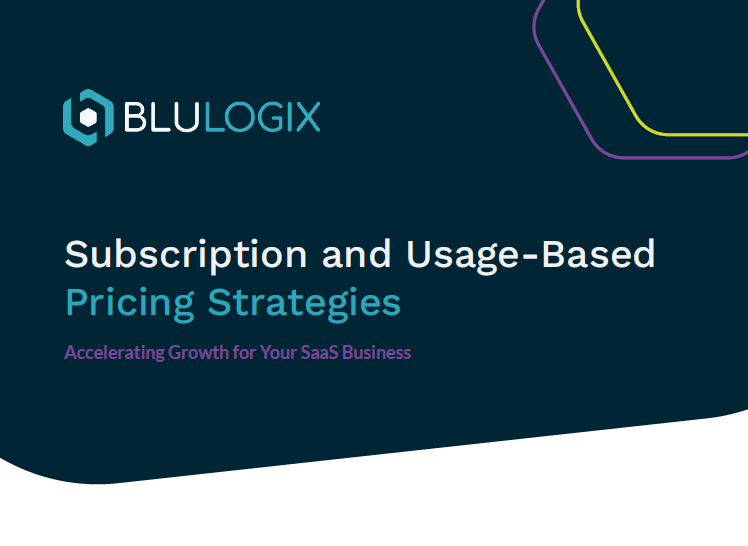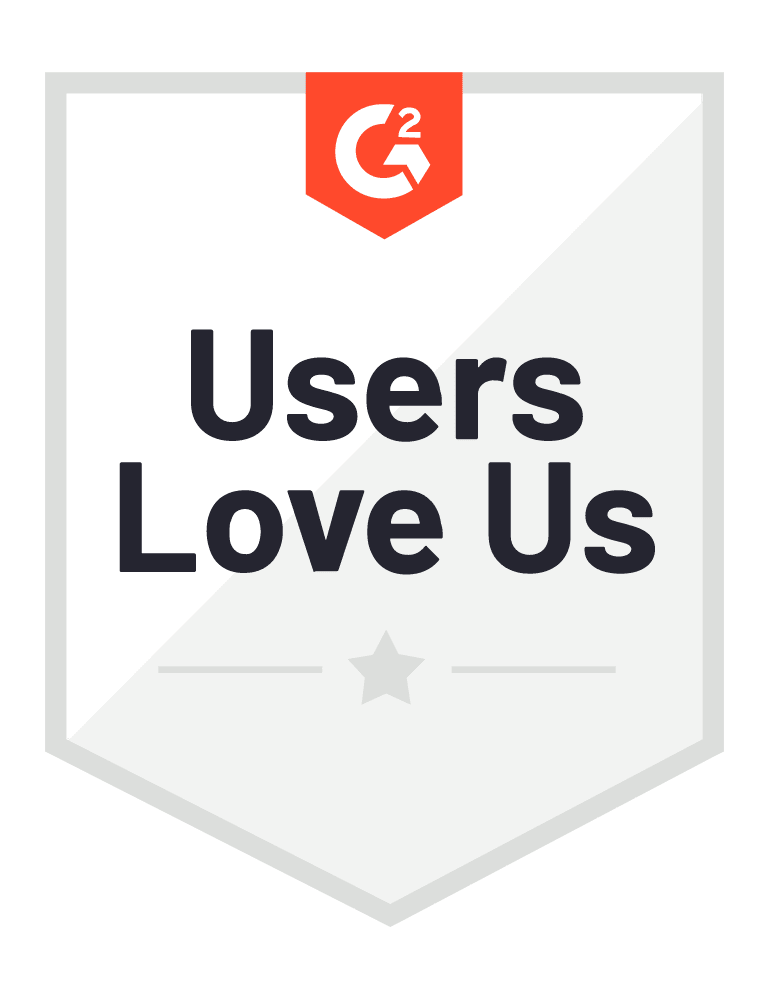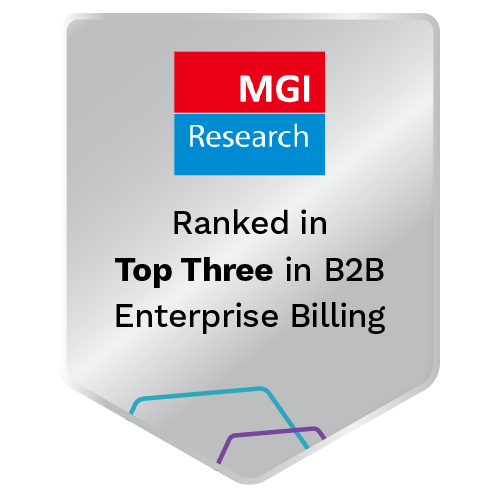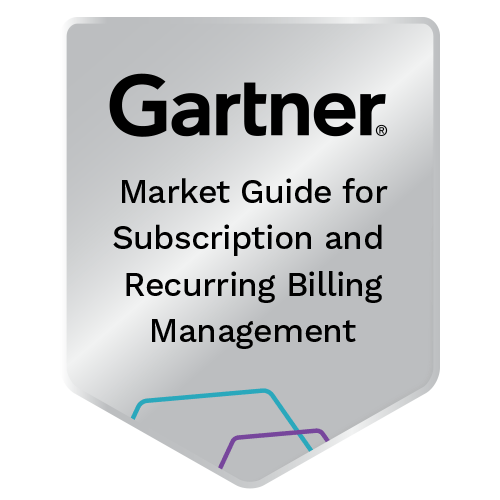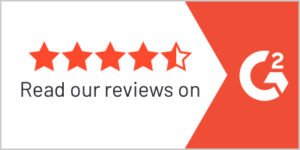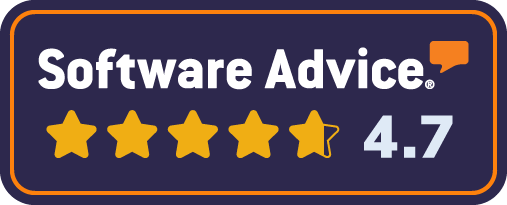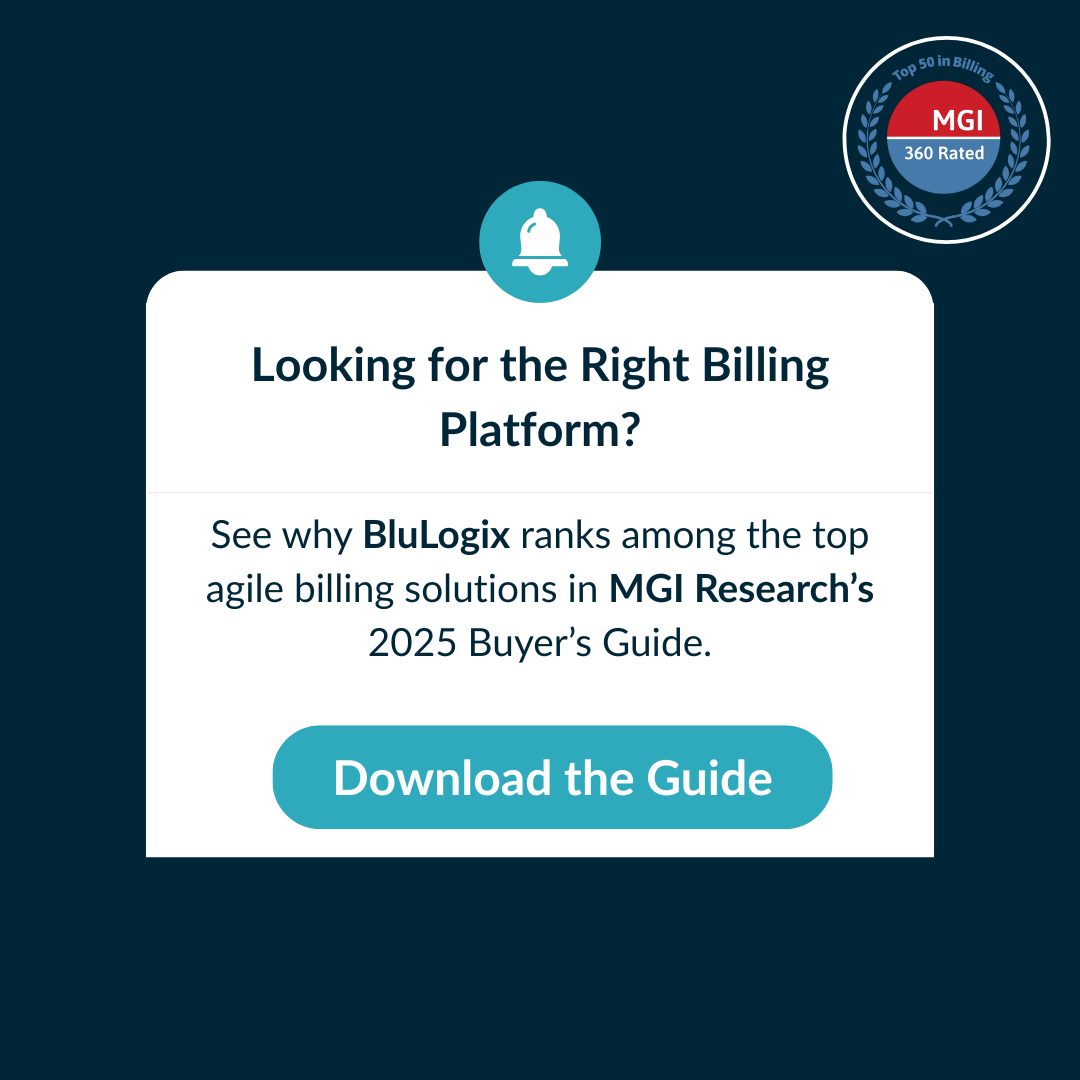Blulogix Whitepaper
Subscription and Usage-based pricing strategies
Accelerating Growth for Your SaaS Business
Table of Contents
Introduction
The SaaS industry has experienced a significant shift in recent years, with recurring revenue models taking center stage. Subscription and usage-based pricing strategies have emerged as powerful tools for accelerating growth and driving success in the SaaS business landscape. By adopting these innovative pricing approaches, SaaS companies can unlock a host of benefits and capitalize on the changing dynamics of the market.
One of the key advantages of recurring revenue models is the stability and predictability they offer. Traditional one-time sales often result in a revenue rollercoaster, making it challenging for businesses to plan and invest in their future. In contrast, subscription-based pricing provides a steady stream of recurring revenue, enabling SaaS companies to protect their revenue streams and make informed decisions regarding business expansion, product development, and customer support.
Usage-based pricing, on the other hand, offers a flexible and customer-centric approach to pricing. With usage-based models, customers pay for the value they receive, aligning the cost with their actual usage of the product or service. This not only ensures a fair and transparent pricing structure but also allows customers to scale their usage based on their evolving needs.
The benefits of subscription and usage-based pricing go beyond revenue stability and flexibility. These pricing strategies also foster stronger customer relationships and increase customer lifetime value. By offering subscription plans, SaaS companies establish a recurring connection with their customers, leading to ongoing engagement and loyalty. Additionally, usage-based pricing incentivizes customers to fully utilize the product, as they only pay for what they use. This drives higher customer satisfaction, as they perceive greater value from their investment.
Furthermore, subscription and usage-based pricing enable SaaS companies to adapt and respond to market demands more effectively. The ever-evolving business landscape requires agility and the ability to adjust pricing models to stay competitive. Subscription and usage-based models provide the flexibility to experiment with different pricing tiers, introduce new features or offerings, and respond to customer feedback and market trends in real time.
In this ebook, we will delve into the intricacies of subscription and usage-based pricing strategies for SaaS businesses. We will explore various pricing models, their benefits and challenges, and provide practical insights on how to design, implement, and optimize these strategies to accelerate growth. By the end of this ebook, you will have a comprehensive understanding of how subscription and usage-based pricing can transform your SaaS business and position you for long-term success.
Let’s embark on this journey to unlock the potential of recurring revenue and discover the strategies that will accelerate growth for your SaaS business.
The Power of Recurring Revenue Models in the SaaS Industry
Introduction:
The SaaS industry has witnessed a paradigm shift in how businesses generate revenue. Traditional one-time sales have given way to recurring revenue models, where companies offer subscription-based pricing and usage-based pricing structures. In this chapter, we will explore the power of recurring revenue models in the SaaS industry and the benefits they bring to businesses. We will also dive into the different subscription pricing models commonly employed in the SaaS landscape.
Understanding the Benefits of Subscription and Usage-Based Pricing:
Subscription and usage-based pricing have revolutionized the way SaaS companies generate revenue. Let’s take a closer look at the key benefits of these pricing strategies:
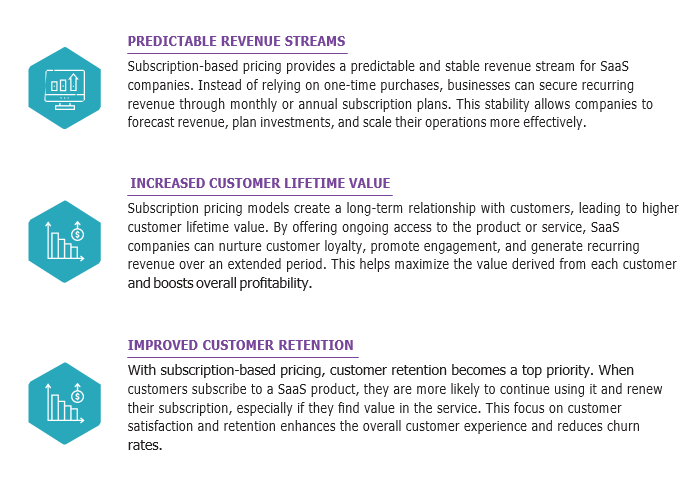
Understanding Subscription Pricing Models:
SaaS companies employ various subscription pricing models to cater to different customer segments and business goals. Let’s explore some of the commonly used subscription pricing models:
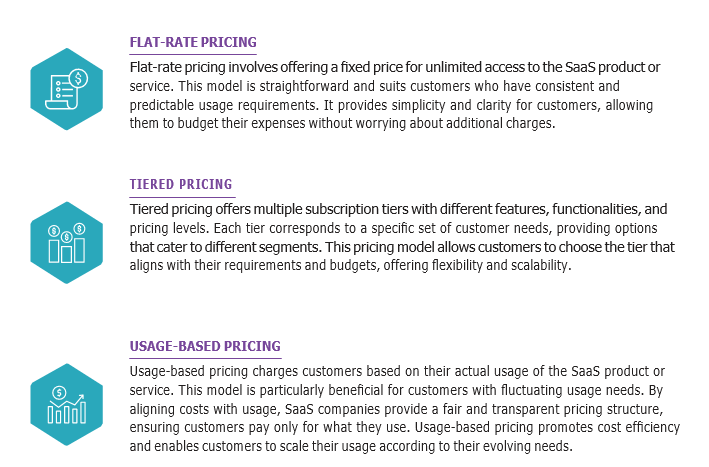
Conclusion
Recurring revenue models, such as subscription and usage-based pricing, have transformed the SaaS industry by offering predictable revenue streams, increasing customer lifetime value, and improving customer retention. Understanding the benefits of these pricing strategies and exploring different subscription pricing models allows SaaS businesses to design effective pricing strategies that drive growth and success. In the following chapters, we will delve deeper into each pricing model and provide actionable insights on implementing and optimizing subscription and usage-based pricing strategies for your SaaS business
Exploring Different Subscription Pricing Models
Introduction:
In Chapter 1, we discussed the benefits of recurring revenue models and the power of subscription pricing. In this chapter, we will delve deeper into the different subscription pricing models available to SaaS businesses. We will explore the characteristics, pros, and cons of each model, and provide insights on choosing the right pricing model for your specific business needs. Additionally, we will explore how leveraging usage-based pricing can drive growth and enhance your SaaS business.
Flat-Rate Pricing Model:
The flat-rate pricing model involves offering a fixed price for unlimited access to the SaaS product or service. Let’s examine the pros and cons of this model:
PROS:
- Simplicity and predictability for customers, as they pay a fixed amount regardless of
- Ease of understanding and budgeting, as there are no additional charges based on
- Reduced administrative complexity, as billing remains consistent across all
CONS:
- Potential revenue limitations, as high-usage customers may pay the same as low-usage
- Limited scalability, as the pricing structure does not directly align with customer usage
- Difficulty in capturing the full value of the product or service if customers underutilize
Tiered Pricing Model:
The tiered pricing model offers multiple subscription tiers with different features, functionalities, and pricing levels. Let’s explore the pros and cons of this model:
PROS:
- Flexibility for customers, as they can choose the tier that aligns with their specific needs and
- Scalability, as customers can easily upgrade or downgrade to different tiers as their requirements
- Opportunity for revenue growth, as higher-tier customers pay more for additional features and
CONS:
- Complexity in designing and managing multiple tiers, including defining the right feature
- Potential confusion for customers when selecting the most suitable tier for their
- Difficulty in maintaining pricing consistency across different tiers and ensuring fairness in value
Usage-Based Pricing Model:
The usage-based pricing model charges customers based on their actual usage of the SaaS product or service. Let’s examine the pros and cons of this model:
PROS:
- Fairness and transparency, as customers pay based on their usage, aligning costs with value
- Cost efficiency for customers with fluctuating or unpredictable usage
- Potential for revenue growth, as higher usage translates to increased revenue for the SaaS
CONS:
- Complexity in determining the right pricing metrics and rates for different usage levels.
- Difficulty in predicting and forecasting revenue due to variations in customer
- Potential challenges in communicating and managing usage-based billing to ensure customer
Choosing the Right Pricing Model for Your SaaS Business:
Selecting the appropriate pricing model for your SaaS business is crucial for success. Consider the following factors when making your decision:
- Customer Needs and Preferences: Understand your target audience and their usage patterns to determine which pricing model best aligns with their requirements and budgetary preferences.
- Value Proposition: Assess the unique value proposition of your SaaS product or service and choose a pricing model that effectively captures and delivers that value to customers.
- Competitive Landscape: Analyze the pricing strategies of your competitors and identify opportunities to differentiate your offering through a pricing model that stands out in the market.
- Scalability and Revenue Goals: Consider your growth objectives and evaluate how each pricing model can support your scalability goals and revenue generation.
Leveraging Usage-Based Pricing to Drive Growth:
Usage-based pricing offers immense potential for driving growth in your SaaS business. By aligning costs with customer usage, you can:
- Encourage Adoption and Expansion: Lower entry barriers by allowing customers to start with minimal usage and scale up gradually as they recognize the value of your product or service.
- Drive Customer Engagement: Usage-based pricing creates incentives for customers to actively engage with your offering, increasing usage and promoting a deeper understanding of its benefits. Maximize Revenue Potential: By accurately capturing and monetizing customer usage, you can ensure that your SaaS business captures the full value of its offerings and optimizes revenue generation.
- Foster Customer Success: Usage-based pricing promotes a mutually beneficial relationship, where customers derive value from your product or service and you, in turn, benefit from their increased usage and loyalty.
Conclusion
Exploring different subscription pricing models, such as flat-rate, tiered, and usage-based, is essential for designing a pricing strategy that aligns with your SaaS business goals. Each model has its own advantages and considerations, and the right choice depends on factors such as customer preferences, value proposition, competitive landscape, and revenue objectives. Leveraging usage-based pricing can further enhance growth by incentivizing customer engagement, driving adoption, and maximizing revenue potential. In the next chapter, we will delve into the implementation and optimization of subscription and usage-based pricing strategies for your SaaS business.
How Usage-Based Pricing Can Boost Customer Acquisition and Retention
Introduction:
In Chapter 2, we explored different subscription pricing models and their pros and cons. In this chapter, we will focus on how usage-based pricing can significantly impact customer acquisition and retention for your SaaS business. We will discuss the importance of aligning pricing with customer value and usage patterns, provide case studies of successful SaaS companies using usage-based pricing, and guide you in designing flexible pricing plans that cater to diverse customer needs.
Aligning Pricing with Customer Value and Usage Patterns:
Usage-based pricing allows you to align your pricing directly with the value customers derive from your SaaS product or service. By charging customers based on their actual usage, you ensure that they pay for what they use and perceive the value they receive. Key considerations include:
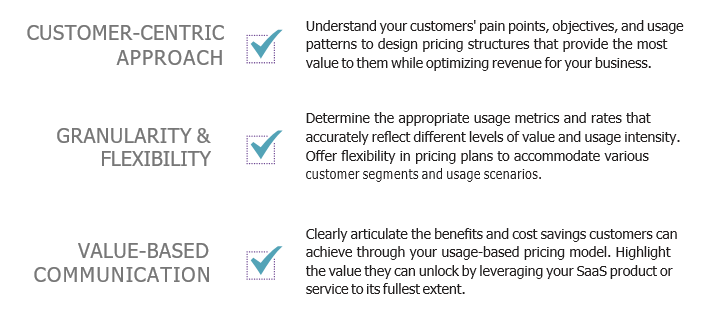
Case Studies of Successful SaaS Companies Using Usage-Based Pricing:
Examining real-world examples of SaaS companies that have successfully implemented usage-based pricing can provide valuable insights and inspiration for your own strategies. Here are a few case studies to consider:
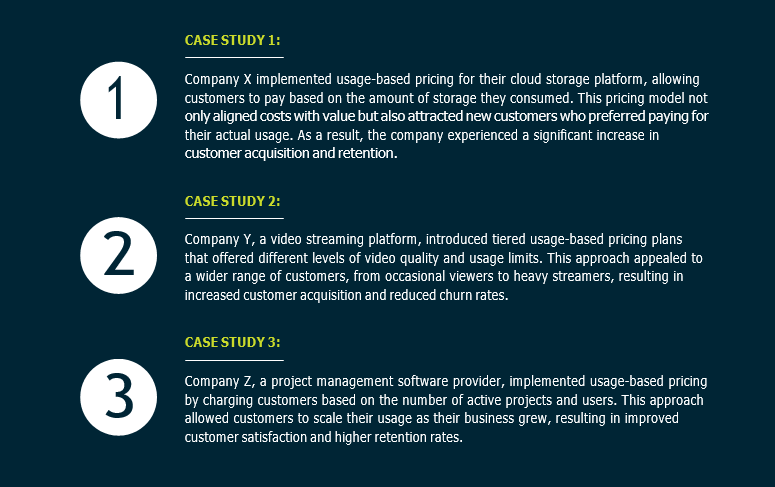
These case studies demonstrate the effectiveness of usage-based pricing in attracting new customers, retaining existing ones, and aligning pricing with customer value and usage patterns.
Designing Flexible Pricing Plans:
To fully leverage the benefits of usage-based pricing, it is essential to design flexible pricing plans that cater to the diverse needs of your customers. Consider the following strategies:

Conclusion
Usage-based pricing has the potential to significantly impact customer acquisition and retention for your SaaS business.
Tailoring Pricing Plans to Meet Customer Needs and Budgets
Introduction:
In Chapter 3, we explored how usage-based pricing can boost customer acquisition and retention. In this chapter, we will delve into the importance of tailoring pricing plans to meet customer needs and budgets. We will discuss the significance of offering add-ons, upsells, and cross-sells to enhance revenue, strategies for pricing experimentation and optimization, and the implementation of effective subscription management techniques.
Offering Add-Ons, Upsells, and Cross-Sells to Enhance Revenue:
To maximize the value you derive from each customer and increase your revenue, it is crucial to offer additional products, features, or services that complement your core offering. Consider the following strategies:
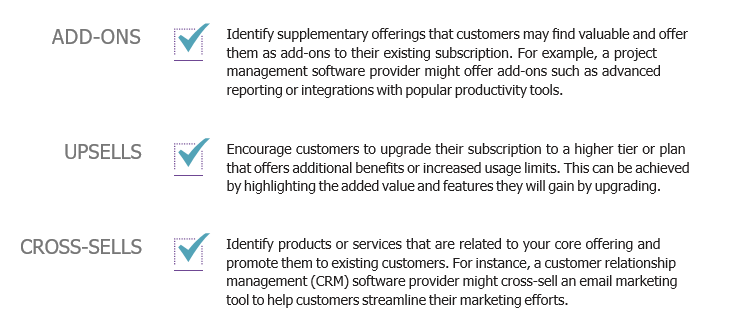
By strategically offering add-ons, upsells, and cross-sells, you can not only enhance customer satisfaction but also increase your revenue per customer.
Strategies for Pricing Experimentation and Optimization:
Pricing experimentation is a critical component of achieving optimal pricing strategies for your SaaS business. Consider the following approaches:
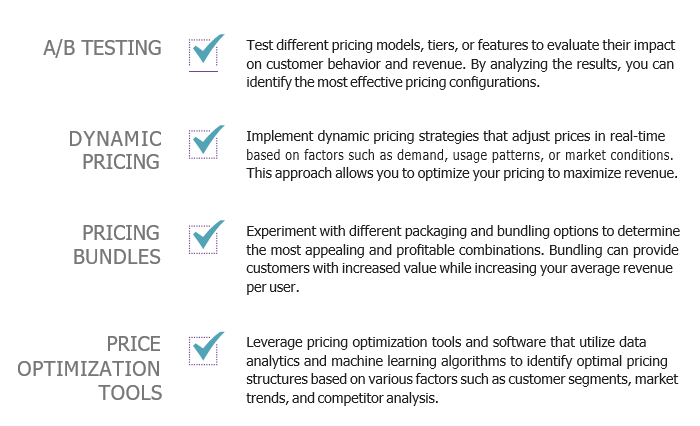
By continuously experimenting with pricing strategies and utilizing advanced pricing optimization techniques, you can ensure that your pricing plans are tailored to maximize revenue while meeting customer needs and budgets.
Implementing Effective Subscription Management:
Efficient subscription management is crucial for ensuring a seamless customer experience and maximizing the value of your SaaS business. Consider the following best practices:
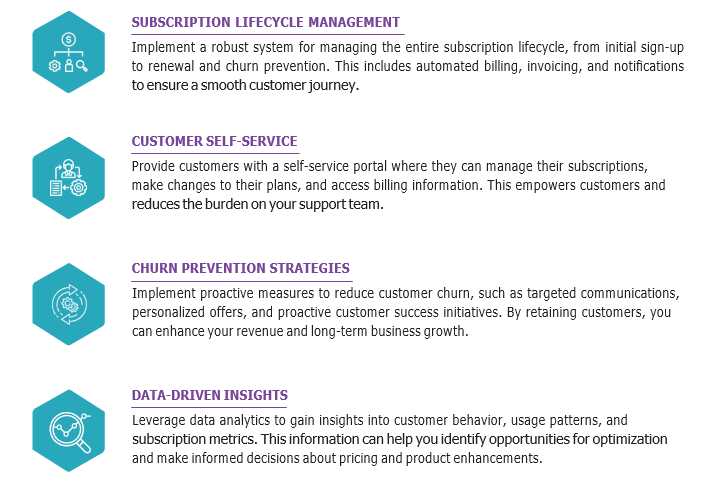
Conclusion
Tailoring pricing plans to meet customer needs and budgets is essential for driving revenue and maintaining customer satisfaction in the SaaS industry. By offering add-ons, upsells, and cross-sells, experimenting with pricing strategies, and implementing effective subscription management techniques, you can optimize your pricing models and enhance your overall business performance.
Key Considerations for Implementing a Subscription Management System
Introduction:
In Chapter 4, we discussed the importance of tailoring pricing plans to meet customer needs and budgets. In this chapter, we will explore the key considerations for implementing a subscription management system. We will delve into the benefits of automating billing, invoicing, and payment processes, managing customer subscriptions, upgrades, and cancellations, and monetizing usage-based metrics.
Automating Billing, Invoicing, and Payment Processes:
Implementing an automated subscription management system can streamline your billing, invoicing, and payment processes, offering several benefits:
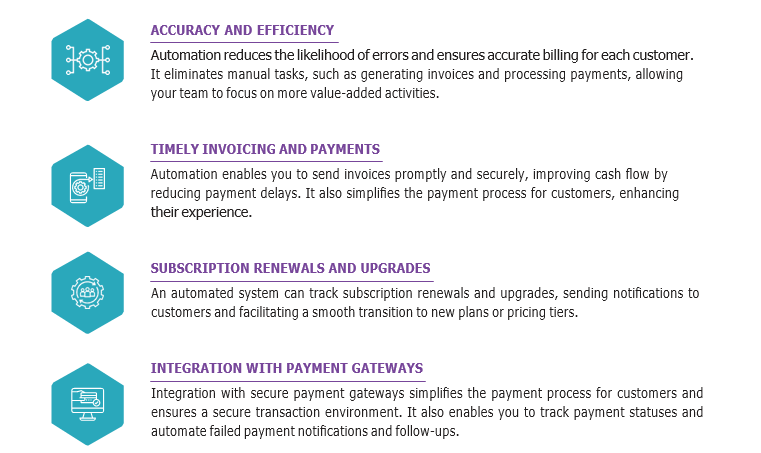
By automating billing, invoicing, and payment processes, you can optimize your revenue collection, enhance operational efficiency, and improve the overall customer experience.
Managing Customer Subscriptions, Upgrades, and Cancellations:
Effectively managing customer subscriptions is crucial for maintaining customer satisfaction and minimizing churn. Consider the following best practices:
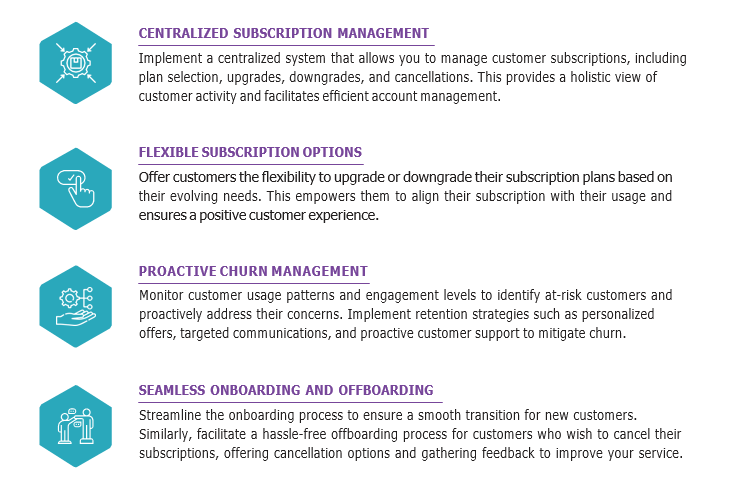
Monetizing Usage-Based Metrics:
Usage-based pricing models offer the opportunity to monetize customer usage and provide a more personalized pricing structure. Consider the following strategies:
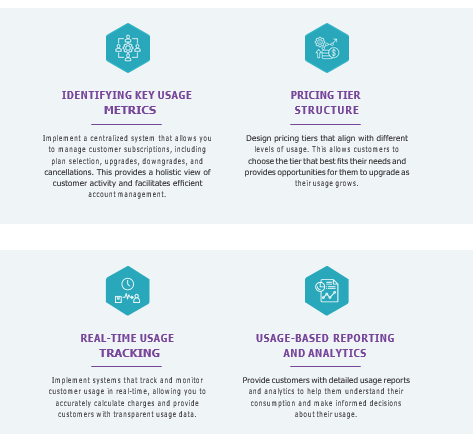
By monetizing usage-based metrics, you can create pricing models that reflect the value customers receive from your SaaS solution, optimize revenue based on actual usage, and foster a mutually beneficial relationship with your customers.
Conclusion:
Implementing a robust subscription management system is vital for SaaS businesses aiming to optimize their pricing models and enhance revenue generation. By automating billing processes, effectively managing customer subscriptions, upgrades, and cancellations, and monetizing usage-based metrics, you can streamline operations, improve customer satisfaction, and drive sustainable growth. In the next chapter, we will explore strategies for marketing and promoting subscription-based pricing to maximize customer acquisition and retention.
Identifying Valuable Usage Metrics to Monetize
Introduction:
In Chapter 5, we discussed the importance of monetizing usage-based metrics in subscription pricing models. In this chapter, we will delve deeper into identifying valuable usage metrics to monetize, implementing pricing strategies for different usage metrics, ensuring accuracy and transparency in usage tracking and reporting, and maintaining effective customer communication and transparency.
Identifying Valuable Usage Metrics:
To effectively monetize usage-based pricing, it is crucial to identify the usage metrics that align with the value your SaaS product delivers to customers. Consider the following steps:
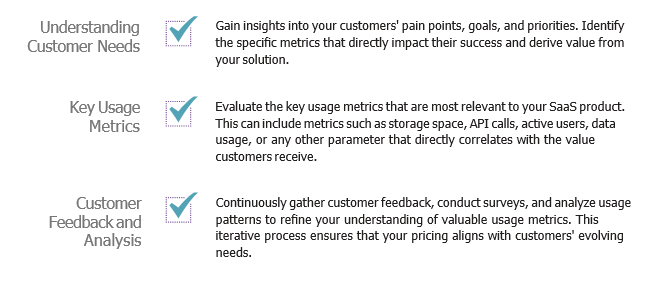
Pricing Strategies for Different Usage Metrics
Once you have identified the valuable usage metrics, it’s essential to design pricing strategies that accurately reflect the value customers derive from those metrics. Consider the following approaches:
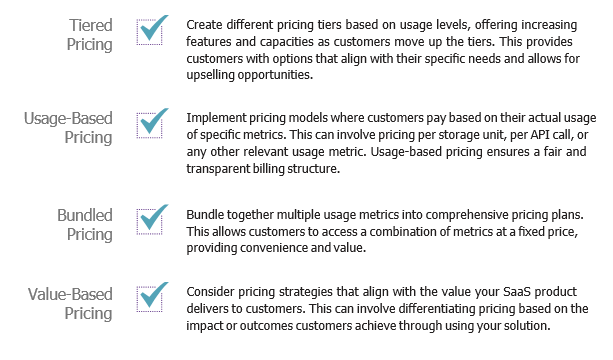
Ensuring Accuracy and Transparency in Usage Tracking and Reporting:
Accurate usage tracking and transparent reporting are essential to maintain trust with your customers. Consider the following practices:
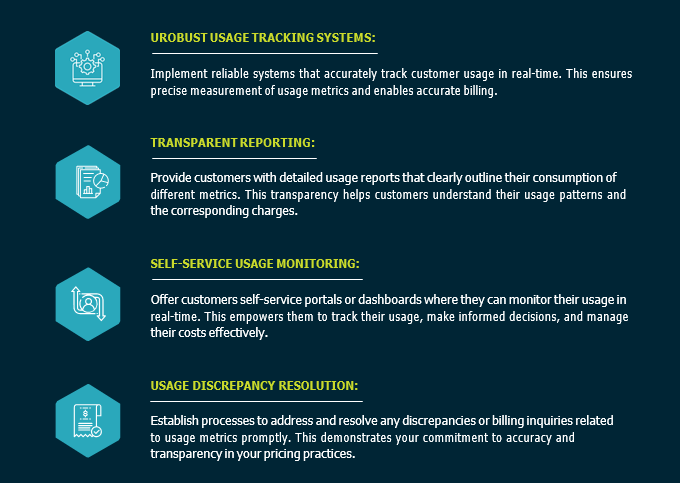
Customer Communication and Transparency:
Maintaining effective communication and transparency with your customers is crucial for building trust and fostering long-term relationships. Consider the following practices:
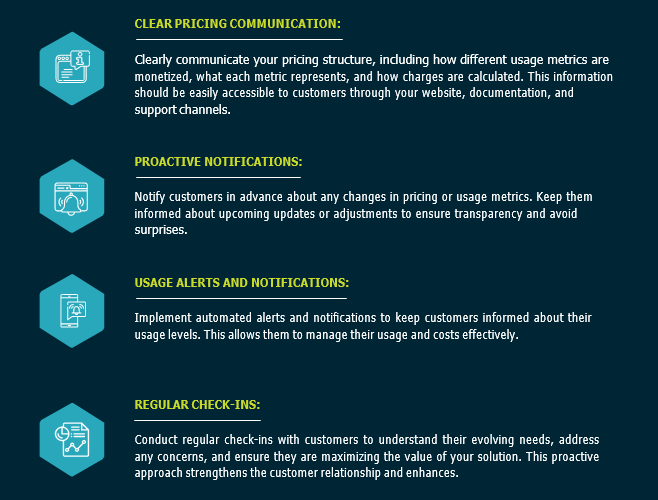
Conclusion
Identifying valuable usage metrics, implementing appropriate pricing strategies, ensuring accuracy in usage tracking and reporting, and maintaining effective customer communication and transparency are essential components of a successful usage-based pricing model. By aligning your pricing with customer needs, providing transparent usage information, and fostering open communication, you can enhance customer satisfaction, drive growth, and establish a solid foundation for your SaaS business. In the next chapter, we will explore strategies for optimizing customer acquisition and retention using subscription and usage-based pricing.
Communicating Pricing Changes and Updates Effectively to Customers
Introduction:
In Chapter 6, we discussed the importance of customer communication and transparency in usage-based pricing. In this chapter, we will focus specifically on communicating pricing changes and updates effectively to customers. We will explore the significance of providing transparent billing and usage information, building trust, and maintaining customer satisfaction through clear communication. Additionally, we will discuss the role of pricing and packaging innovation in enhancing the customer experience.
Providing Transparent Billing and Usage Information:
Transparent billing and usage information are vital aspects of customer communication in the context of pricing changes. Consider the following practices:
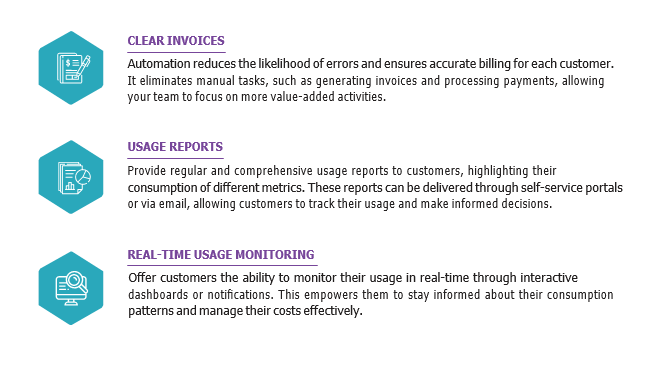
Building Trust and Maintaining Customer Satisfaction through Clear Communication:
Clear communication is crucial for building trust and maintaining customer satisfaction when communicating pricing changes. Consider the following strategies:
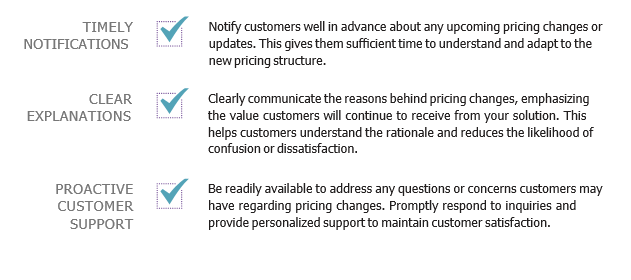
Pricing and Packaging Innovation:
In addition to effective communication, pricing and packaging innovation play a crucial role in enhancing the customer experience. Consider the following approaches:
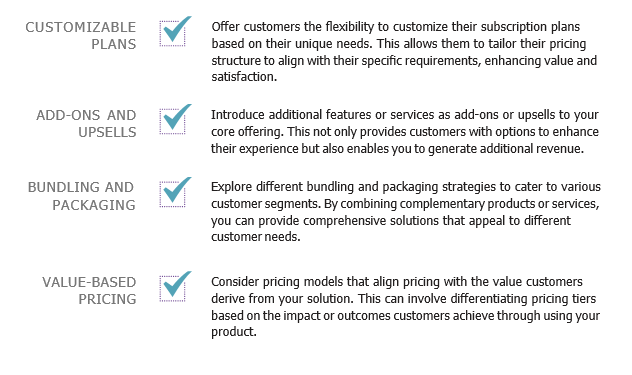
Conclusion
Communicating pricing changes and updates effectively to customers is a critical aspect of managing a successful subscription and usage-based pricing strategy. By providing transparent billing and usage information, building trust through clear communication, and embracing pricing and packaging innovation, you can enhance the customer experience, maintain satisfaction, and drive growth. In the next chapter, we will explore strategies for effectively managing customer acquisition and retention using subscription and usage-based pricing.
Innovating Pricing Models to Differentiate Your SaaS Offering
In Chapter 7, we discussed the importance of effective communication and transparency in pricing changes. In this chapter, we will delve into the topic of innovating pricing models to differentiate your SaaS offering. We will explore the potential of hybrid pricing models and value-based pricing, as well as the significance of incorporating feedback and insights from customers into pricing decisions. Additionally, we will address the challenges and complexities involved in managing pricing strategies.
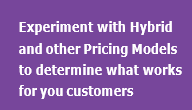
Exploring Hybrid Pricing Models:
To stand out in a competitive market, SaaS companies must consider innovative pricing models that go beyond traditional approaches. Hybrid pricing models provide a unique opportunity to differentiate your offering. Consider the following strategies:
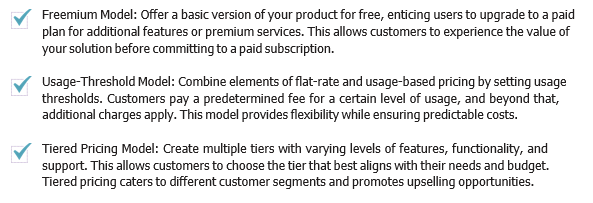
Exploring Hybrid Pricing Models:
Value-based pricing focuses on aligning the price of your SaaS offering with the value it delivers to customers. Consider the following strategies:
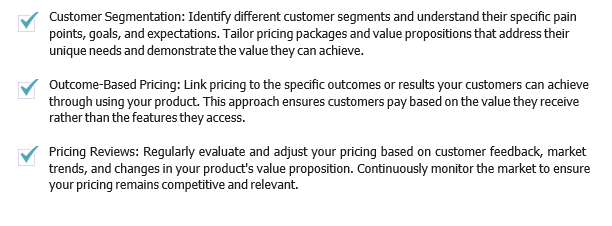
Incorporating Feedback and Insights from Customers:
To develop effective pricing models, it is crucial to incorporate feedback and insights from customers. Consider the following practices:
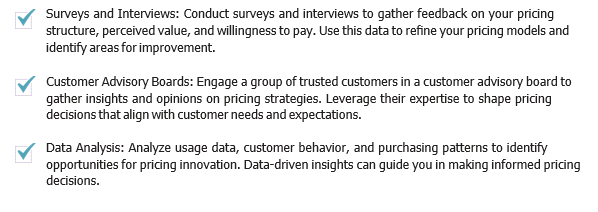
Managing Pricing Complexity and Challenges:
Implementing innovative pricing models can introduce complexities and challenges. Consider the following strategies to overcome them:
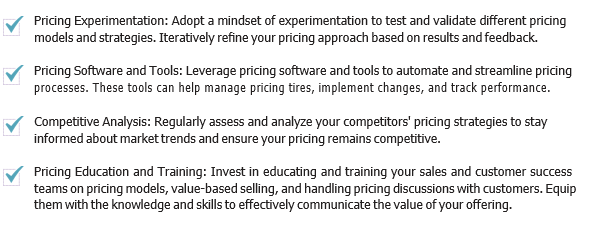
Conclusion
Innovating pricing models is essential for differentiating your SaaS offering in a competitive landscape. Hybrid pricing models and value-based pricing enable you to align pricing with customer needs and deliver unique value propositions. By incorporating feedback and insights from customers, you can refine your pricing strategies and drive customer satisfaction. In the next chapter, we will address the importance of effective subscription management and discuss strategies for optimizing subscription workflows.
Overcoming Challenges in Implementing and Managing Complex Pricing Structures
Monetize Usage-Based Metrics:
- Identify the most valuable usage metrics for your SaaS product and determine the appropriate pricing strategies for each metric (e.g., storage, API calls, active users).
- Ensure accurate and transparent tracking and reporting of usage data to maintain customer trust and satisfaction.
Keep Up with Market Trends in SaaS Pricing and Subscription Models:
- Continuously monitor and analyze market trends in SaaS pricing and subscription models to stay ahead of the competition.
- Optimize your pricing approaches based on data-driven insights and customer feedback, ensuring your pricing strategy remains relevant and competitive.
Conclusion:
In this chapter, we have recapped the key takeaways and strategies for success in implementing subscription and usage-based pricing models for your SaaS business. By understanding the power of recurring revenue models, exploring different pricing models, leveraging usage-based pricing, tailoring pricing plans to customer needs, implementing effective subscription management, communicating pricing changes effectively, innovating pricing models, overcoming challenges, and keeping up with market trends, you will be well-equipped to accelerate growth and drive success in the dynamic and competitive SaaS industry. Remember, pricing strategies require continuous evaluation and optimization to ensure they remain aligned with customer value and business goals. As you navigate the ever-evolving landscape of the SaaS industry, use the knowledge and insights gained from this book to leverage pricing as a growth accelerator for your business.
Final Thoughts
Congratulations!
You have reached the end of this ebook on Subscription and Usage-Based Pricing Strategies, where we have explored the power of pricing as a growth accelerator in the SaaS industry. Throughout the chapters, we have discussed various concepts, strategies, and case studies to help you understand the importance of pricing and how it can drive your SaaS business forward.
Pricing is not merely a transactional aspect of your business; it is a strategic lever that can have a significant impact on your revenue, customer acquisition, retention, and overall business success. By adopting subscription and usage-based pricing models, you unlock the potential for recurring revenue streams, align your pricing with customer value, and create sustainable growth opportunities.
As you conclude this ebook, remember that pricing strategies require continuous evaluation and optimization. What works today may not work tomorrow, as market dynamics evolve, customer expectations change, and new trends emerge. Stay curious, remain customer-centric, and be open to experimentation and adaptation.
Leveraging pricing as a growth accelerator in the SaaS industry is a journey that requires ongoing dedication and strategic thinking. By implementing the strategies and insights shared in this ebook, you are equipped with the knowledge and tools to thrive in a competitive landscape.
Now it’s time to take action. Assess your current pricing strategy, identify areas for improvement, and start implementing changes that will drive growth for your SaaS business. Embrace the power of pricing, leverage recurring revenue models, and watch your business soar to new heights.
Best of luck on your pricing journey, and may your SaaS business experience tremendous success through the effective utilization of subscription
Complexity Simplified
Handling a full range of billing scenarios, from the very simple to the most advanced and complex, including multiple usage-based microtransactions per day, while servicing multiple channels and different tiers of customers and recurring subscriptions, BluLogix offers a cohesive overall approach to the quote-to-cash process.
with one of our billing experts below and we’ll show you how BluLogix accelerates revenue growth, enables digital transformation and empowers channels.
Reviews

Michael R.
President, Allnet Air Inc. - Telecommunications
Best Outsourced Billing for Mobility

Karen R.
Manager, Cloud Billing - Computer Software
BluLogix has been a great partner.
“Over the last several years, I have seen continual enhancements and additions to the platform. BluLogix has created a comprehensive solution for users. They provide great communication regarding upgrades and address concerns thoroughly and timely.”

Sara K.
Marketing, Graphic Design & Social Media Management - Marketing and Advertising
Fantastic platform. Recommend!

